Do You Wear Socks With Compression Socks?
Compression socks are a kind of stocking that applies inward pressure to the lower legs and feet. Their purpose is to promote proper circulation and fend off swelling in the extremities caused by long hours of sitting or standing.
Compression socks have been with us for nearly 80 years but only in the past 20 years or so have they seen widespread use. That surge in use can be attributed to our increasingly sedentary lifestyle. And the fact that more people than ever fly regularly or work at computers where they barely move for hours at a time.
There are literally hundreds of different compression socks on the market today from dozens of different manufacturers. Some are well worth the investment. Others aren't. We've separated the wheat from the chaff for you and compiled the following list of the 10 best compression socks for 2021.
Rankings
1. Physix Gear Sport Compression Socks
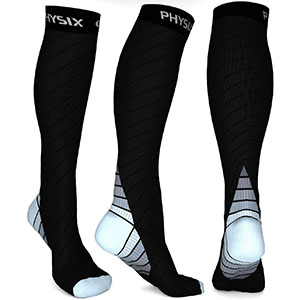
Click here for the lowest price on Amazon
These compression socks from Physix provide nice firm compression from toe to calf. That's at least in part due to the 30% Spandex in the weave. They also feature friction-free seams for all day comfort and antibacterial, quick dry fabric. Toss in the affordable price point and they're our #1 choice.
What we like: The graduated compression at work here may be among the most effective you'll find. You can feel it at work from toes to calf. They also do a good job retaining their elasticity. Not something you can say about all compression socks.
They're warm enough to wear in cold weather and the friction-free seams won't rub you the wrong way even on at 10 hour flight. Lots of support through the arch as well.
Flaws: They tend to be tight up top. So if you have thick legs you might think the calf compression to be a bit much.
2. SB SOX Compression Socks
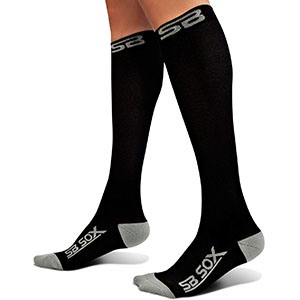
Click here for the lowest price on Amazon
These are handsome, well-made compression socks that provide effective protection against edema and effective relief for varicose vein sufferers. They're available in a wide array of colors that range from all-black for work to Cat in the Hat stripes for play.
What we like: These socks gradually increase compression from toe to cuff, where you'll enjoy a firm 30 mmHg of pressure. At the same time they're very breathable and do a good job wicking away moisture.
They stay up when you put them on. They have a nice smooth feel to them that makes wearing them all day a relative breeze. And they're available in a wide range of colors and patterns.
Flaws: You need to follow the washing instructions to the letter or they're likely to shrink.
3. Vitalsox Italy Graduated Compression Socks
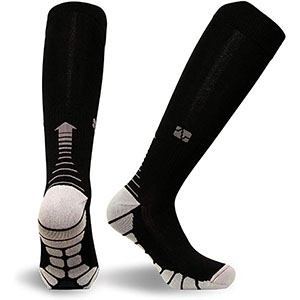
Click here for the lowest price on Amazon
If you like your socks warm and colorful and comfortable you will likely take a shine to these graduated compression socks from Vitalsox. They're made in Italy, feature moisture wicking material and offer lots of arch support for those with plantar fasciitis.
What we like: Polypropylene makes the socks very comfortable and warm and does a good job wicking moisture away. It's also fungus resistant. The graduated compression makes them good for all day wear.
They also offer surprisingly good support through the arch. So if you suffer plantar fasciitis you may want to consider these as your go-to compression socks.
Flaws: The graphic touches on the sole with the 'arrow' extending up from the heel may disqualify them as office wear.
4. Rockay Vigor Graduated Compression Socks

Click here for the lowest price on Amazon
These Rockay Vigor Graduated Compression Socks are a great choice for athletes, waiters and others who spend long hours on their feet. They're light and breathable yet they grab hold of your lower legs and don't let go. They're also made of 100% recycled materials.
What we like: We really appreciate that these socks are made from recycled material. Beyond that, the weave is intended to favor the active individual in that it produces very little irritation if you wear the socks running or power walking.
They're a good choice for environmentally conscious, physically active older folks. They do a good job wicking away moisture and keeping odors at bay. And they do a good job retaining their form.
Flaws: They're pretty expensive and you'll need to hand wash them. But, because of how they're made we'll look the other way on that.
5. Treat My Feet Compression Socks for Women & Men
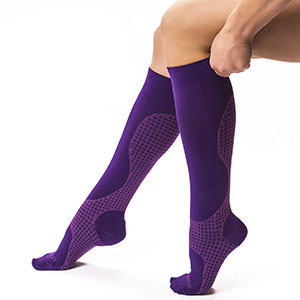
Click here for the lowest price on Amazon
You can feel the energy coursing through these socks from the arch up through the ankle to the calf. They make you feel like getting up and doing something and they're certainly colorful enough to wear to the gym or the Crossfit box. They're also affordable and don't suffer from being tossed in the washing machine.
What we like: We like the way they get right to work reinvigorating your legs. The graduated compression is very effective, even after long hours at the desk.
The Spandex in the weave keeps them snapping back to their original shape longer than some other socks. And the moisture wicking material fends off noxious odors.
Flaws: They don't let up on the compression right through the toe box. Some folks might find that a bit much.
6. Vitalsox Travelsox TSS6000
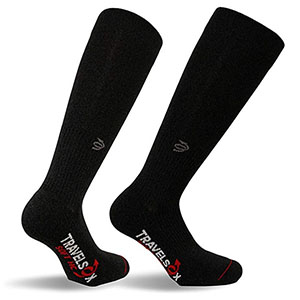
Click here for the lowest price on Amazon
Unlike the other Vitalsox offering on our list that consciously embraces playful colors, these TSS6000 socks are intended for office, dinner or other, more formal occasions. They extend right up to the top of the calf, aren't as difficult as some to pull on and they're 100% recyclable.
What we like: We like the 4-way stretch that lets you find just the right fit. The graduated compression is quite effective up through the calves. They also do a good job wicking away moisture, which keeps the odors at bay.
They're available in a wide variety of colors and most are very subdued. So you can wear these to the office no problem. And they stand up to multiple trips through the washing machine.
Flaws: The elasticity begins to lose responsiveness after a half dozen or so wears. Not to any great degree, but it's noticeable.
7. Zensah Tech+ Compression Socks
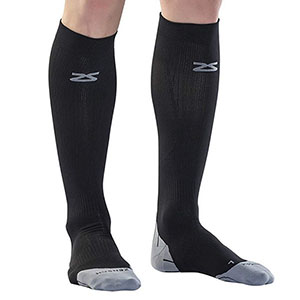
Click here for the lowest price on Amazon
There's a healthy dose of elastane in the weave of these Zensah Tech+ Compression Socks. That ensures they'll retain their snug fit for a good long time. The compression is graduated from seamless toe to the cuff and doesn't interfere with breathability.
What we like: We really like the way these socks feel. They grab hold of your lower leg in a gentle but firm manner and don't let go. The material is very durable and they make good cold weather socks. Or at least cold weather foundation socks.
The 18% Elastane in the weave also ensures that they're going to spring back into shape for a good long time. And we can't forget the elasticized band that encircles the arch, providing generous support to the plantar fascia.
Flaws: That firm hold we mentioned might be a bit too firm for some folks.
8. Wanderlust Air Travel Compression Socks

Click here for the lowest price on Amazon
Wanderlust Air Travel Compression Socks are for those who want a little more comfort from their socks. There's a bit of padding added at strategic points and the cuff is designed to go easy on your upper calf while still holding firm. The arch support is also first rate.
What we like: They actually live up to their claim of providing robust arch support. They do a good job fending off swelling in the lower legs, even after long days at the desk. And they tend to stay up.
They toss in a bit of extra padding in the heel and at the ball of the toe. And they feature friction-free seams that won't irritate your skin no matter how much you wear them.
Flaws: As comfy and effective as they are they're not exactly the handsomest socks on the shelf.
9. Laite Hebe Compression Socks for Men and Women
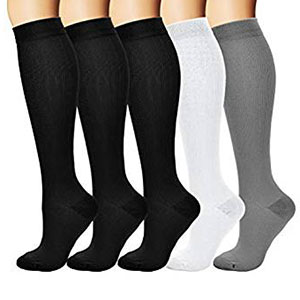
Click here for the lowest price on Amazon
The last of our best compression socks are these from Laite Hebe. These unisex socks are available in a dizzying array of colors and patterns and provide firm, comfortable support. A good choice for anyone who spends big chunks of the day sitting.
What we like: We appreciate the combination of light weight and firm compression. We like that they come in more styles and colors than you can shake a stick at. And we really appreciate that you get a half dozen pairs for a very reasonable price.
We also appreciate that these are true 'over the calf' compression socks. That's important for people who have reason to fear DVT. Good for young or not so young, digital nomads or frequent flyers.
Flaws: They lose elasticity after a few trips through the washing machine. So it's a good thing they send you so many pairs.
10. Danish Endurance Graduated Compression Socks
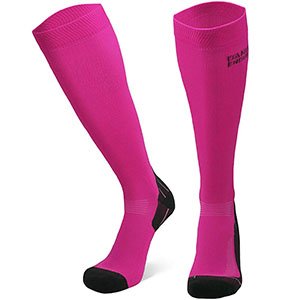
Click here for the lowest price on Amazon
If you put a premium on comfort Danish Endurance Compression Socks are going to bring a smile to your face. They feature graduated compression, but it tops out at a pretty moderate level of 18-21 mmHg. Ideal for the athletically inclined who aren't suffering any particular maladies.
What we like: They're specifically designed for physically active folks. But they'll work for anyone, including waitresses and digital nomads. They're available in a range of sporty color combinations, but also basic black for the office.
We like the extra cushioning in the sole and the moisture wicking material keeps your feet from getting damp and stinky. They're also affordable.
Flaws: If we had to nitpick we might mention that they cuff tends to loose elasticity before the rest of the sock.
What are compression socks?
Compression socks are a type of stocking that features a very tight weave that brings inward pressure to bear on your lower legs and feet. This compression of the lower extremities has the benefit of promoting the proper flow of blood, lymphatic fluid and other bodily fluids. Even when a person has been sitting or standing for many hours in a row. That increased flow reduces the chance of edema, which is the swelling of bodily tissue caused by trapped fluids. Compression socks are widely available, generally inexpensive and very useful in fending off myriad potential health problems.
How We Ranked
There are a surprising number of things to consider when contemplating compression socks. Although if you're in a hurry you can't really lose by just grabbing a pair of uniform compression socks off the drug store shelf.
The compression level of the socks is important of course. And this becomes more of an issue if you are looking at socks that offer graduated compression. Keep in mind that the compression level will determine how much pressure is brought to bear on your legs and feet.
30-40 mmHg is considered very firm compression. While 10-15 mmHg is considered mild compression. If you are having problems with circulation you may want to opt for the higher compression. If you're just wearing these socks as a precaution, then more mild compression will probably suffice.
One of the major issues with compression socks is how well they retain their elasticity. If a certain brand of sock uses Spandex (1) – sometimes referred to as 'elastane' or 'lycra' – in the weave there's a pretty good chance it's going to retain its elasticity for a good long time. And that's what we want to see.
But beyond elasticity we also want a sock that's going to wick away moisture (i.e. sweat). So we look for things like polypropylene, which is known for doing just that. We also want socks that won't irritate the skin. So no latex.
Different manufacturers tend to have different sizing systems. Some provide limited sizing choices (small, medium, large, extra-large etc), while others use either American or international sizing regimes. Most of the compression socks we tested were more or less accurate when it came to sizing. If we thought sizing was an issue we made note of it.
Finally, we don't believe you should have to wash compression socks by hand. So we prefer those that are machine washable. But not all compression socks stand up to the rigors of the washing machine. So if a pair of socks began to show a loss of integrity after just a couple of wash cycles it didn't make our list.
Benefits
Compression socks improve circulation in your lower legs and feet. Which is the most common reason people wear them to begin with. Poor circulation in the lower extremities is often an issue for people who sit for long hours whether at work, on airplanes or just watching TV. But they are not the only ones who suffer lower body circulatory problems. The older we get and the more time we spend essentially sedentary the more swelling of the extremities becomes an issue (2) and the more important it becomes to invest in some good compression socks.
Compression socks help fend off deep vein thrombosis. Deep vein thrombosis (3), or DVT for short, is a serious condition characterized by the formation of blood clots. These blood clots most often occur in the lower extremities and are most often the result of sitting or standing for long stretches at a time. If one of these blood clots breaks free and makes its way to the lung it can cause a potentially deadly problem known as a pulmonary embolism (4). Preventing DVT is one of the major benefits of compression socks.
Compression socks help stave off varicose veins. In some cases varicose veins (5) appear as tiny, spider web type veins on the legs. In other cases they may take the form of bulbous veins protruding outward from the surface of the skin. And in still other cases a person may manifest both types of varicose veins. They can actually be very painful and they often drain the sufferer of energy, making it difficult for them to engage in vigorous activity. Wearing compression socks regularly, especially if you are on your feet a lot, can help fend off the development of varicose veins.
Compression socks are good for people who fly a lot. Anyone who has flown is familiar with the ordeal of having to sit still in a confining little seat, often for hours on end. This can cause fluid to accumulate in the lower legs and feet (6), raising the specter of DVT and other problems. Compression socks are often called 'travel socks' for a reason. Because they are just as important for frequent flyers as they are for those who spend their day sitting in front of a computer screen.
Compression socks are ideal for those who work at a desk all day long. Speaking of sitting in front of a computer screen all day… Doctors have long known the risks involved with sitting too long. In our increasingly high-tech, service-oriented economy where people routinely spend all day at the computer, this risk has become magnified. In fact, studies suggest that people who sit stationary for long periods of time every day stand just as great a chance of dying prematurely as those who smoke (7). The solution? Stand up and move around at regular intervals and wear compression socks.
Compression socks can help prevent orthostatic hypotension in older folks. Ever feel dizzy when you stand up? That's called 'orthostatic hypotension' (8). While it can affect anyone with low blood pressure it's most prevalent in older individuals. It's caused by blood rushing to the legs when you stand, leaving you lightheaded. In some cases it may cause a person to pass out. But it's not typically that severe. Wearing compression socks can help prevent orthostatic hypotension, or at least minimize its effects.
Compression socks can help alleviate the aches and pains caused by varicose veins. This is true no matter how severe they may have become. We talked earlier about preventing varicose veins with compression socks. But for some folks it's too late. They are already beset by this troubling condition. But even if that's the case it's not too late to pick up some compression socks and start enjoying a bit of a respite from the aches and pains the condition can cause.
Compression socks can help athletes perform better. In many cases athletes spend time standing around on the sidelines waiting for their number to be called so they can get in the game. Or they're forced to spend long hours on flights traveling between games. Because of this they are often at risk of developing swollen legs, and perhaps suffering DVT (9). Lower leg swelling is going to interfere with their ability to perform at their peak should they be called upon. And DVT, of course, could be life threatening. Wearing compression socks is a good idea for all types of athletes and will keep the blood moving in their lower legs.
Compression socks can aid in more effective lymphatic drainage. This is not something that is commonly talked about when discussing the benefits of compression socks, but it should be. The lymphatic system essentially is our body's way of disposing of dangerous toxins. Should the lymphatic system become clogged this toxic fluid will begin to accumulate in the tissue, causing a condition called 'lymphedema' (10). In the case of people who sit for long hours, it typically accumulates in the legs and feet.
Compression socks make your career possible. Think about it. Does your job require that you sit at a computer all day doing research or trading stocks or writing? If so, then you're going to need compression socks sooner or later. Or you're going to have to find another career. This is not hyperbole. It's a fact of modern life. In that sense compression socks are very much responsible for you being able to do the type of work you want to do. So next time you're telling your friends how much you love your job, remember that without compression socks your life might be very different.
FAQs
Q: Who needs compression socks?
A: Compression socks are useful for office workers, athletes, travelers, waiters or anyone who spends an inordinate amount of time sitting or standing. The prevent bodily fluids from collecting in the lower extremities, thereby fending off a range of various health conditions including varicose veins, deep vein thrombosis and more.
Q: What is 'graduated compression?
A: There are two different kinds of compression socks. Those that apply even, or uniform, compression and those that apply graduated compression. The amount of compression in this type of sock is usually expressed using the mmHg scale (11). mmHg is the amount of pressure that would be necessary to support a vertical column of mercury 1 millimeter in height.
Exactly who decided that was a useful way to measure pressure is something of a mystery. Although mercury's sensitivity to atmospheric pressure has long been exploited in standard thermometers. That said, with graduated compression socks you'll see a lower mmHg reading toward the toe and a larger reading up toward the knee. This configuration is said to promote better blood circulation in the lower legs than uniform compression. Although there is some medical research that disputes that notion (12).
Q: Are compression socks ruined if they develop a run?
A: Some people throw their compression socks away the minute they develop a run. Others continue to wear them with the run. So who is right? Well, they both are actually. Whether or not a run will ruin your compression socks depends in large part on where the run is located and how severe it is.
If it's a tiny run up by the knee chances are your socks will be largely unaffected. On the other hand, a large run that extends from the calf to the heel, or from the toes up past the ankle is probably going to undermine the effectiveness of the socks and they should be tossed. The best way to avoid runs is to be careful when putting them on.
Q: Do compression socks have any side effects?
A: The side effects of wearing compression socks are almost all positive. Avoidance of DVT, better overall health, better physical performance and such. Typically, if there are any negative side effects they are a consequence of the socks not fitting properly. Either that or the person has an allergy to the material(s) used to make the socks. Latex, for instance, is a common skin irritant (13). If you have a specific medical condition such as varicose veins you may want to discuss compression socks with your doctor to make sure you get the right type.
Q: Can anyone wear compression socks?
A: There is no medical reason why an otherwise healthy person can't wear compression socks if they feel they need them. The only people who might want to discuss it with their doctor first are, as we said, those with specific medical conditions that may be affected by the presence of the socks. That includes varicose veins, diabetes (14), peripheral artery disease or skin infections. Even then it's likely just a matter of getting the right kind.
Q: Can I use skin lotion under compression socks?
A: It's not advised that you put compression socks on immediately after applying lotion to your legs. Simply because some of it will be absorbed into the sock and may be difficult to clean out. If you wish to use a moisturizer or other skin lotion on your legs you should do so at night before you go to sleep. Or after you take the socks off for the day. Be mindful too that petroleum jelly (sometimes referred to on labels as 'petrolatum') will have an adverse reaction to any socks containing latex.
Q: What's the right way to size compression socks?
A: Many types of compression socks are available in small, medium, large and extra-large sizes. In which case you will need to approximate which size is right for you. Some manufacturers though use a more precise sizing system that aligns with shoe sizes. That will be self explanatory. Maybe the biggest decision you'll have to make is whether to buy mid-rise or knee-high socks. Many doctors fell the full knee-high sock does a better job preventing edema (15) in the legs.
Q: Are socks with uniform compression effective?
A: As we mentioned earlier there are 2 types of compression socks. Those that provide graduated compression and those that provide uniform compression. Uniform compression socks are typically a fine choice for just about anyone. They were, in fact, the only choice from the time they were invented in the 1940s (16) until graduated compression socks became available in the 1980s. It wasn't until the 1990s that graduated compression socks became widely thought of as the superior choice. That said, uniform compression socks are still considered effective.
Q: Does Medicare cover compression socks?
A: Medicare does not cover the cost of compression socks (17). Even if they are prescribed by a doctor. A lot of people are surprised by this, considering what an important role they can play in preventing serious health problems like DVT. Some private insurance companies, however, will cover the cost of compression socks if they are prescribed by a physician. Check the fine print of your policy or call your insurance rep to find out.
Q: Should compression socks be hard to put on?
A: People are often put off by how difficult it can be to put compression socks on. And indeed, for those that suffer from severe arthritis they may be nearly impossible to put on without help. But the truth is, if they are not difficult to put on then they are probably not going to do much good. There are some assistive devices that can make putting compression socks on a bit easier. Your doctor or pharmacist should be able to help choose the best one for you.
Q: Can I wear two pairs at once?
A: Some folks believe doubling up on compression socks will provide an extra level of effectiveness. And, perhaps surprisingly, they're right. Wearing 2 pairs of compression socks may indeed provide extra protection against DVT or extra relief from the aches and pains of varicose veins and other maladies. In fact, doctors sometimes advise patients to double up on compression socks.
Q: Should I wear compression socks all day?
A: Whether you should wear compression socks all day long depends on why you are wearing them in the first place. If you wear compression socks at work strictly as a precaution against developing edema, there's no reason you can't take them off once you get home. On the other hand if you didn't start wearing them until you were already experiencing edema you should probably wear them during all waking hours.
Related Articles
Knee sleeves
Back braces
Ankle braces
Knee braces
Tennis elbow braces
Recap
Compression socks have become an essential article of contemporary clothing. Whether you sit all day on the job, spend long hours standing either for work or play or you are a frequent flyer you can likely benefit from wearing compression socks. Uniform compression socks have been around the longest and will provide a very real benefit. Although these days graduated compression socks are considered slightly more effective.
The good news is that you don't need a prescription to buy compression socks. They are readily available online or through a plethora of brick and mortar retail outlets. That said, if you suffer from diabetes or another condition that may be directly affected by them, you should probably discuss it with your doctor before you begin wearing them.
All of the compression socks on our list have proven themselves to be effective at staving off the typical dangers associated with edema. All are well-made, stylish and durable and any one of them should serve you well.
For cpoe.org's #1 recommended pair of compression socks, click here.
Do You Wear Socks With Compression Socks?
Source: https://cpoe.org/compression-socks/